Shooting outside is fun until the wind decides to crash your audio. Suddenly, your voice sounds muffled, shaky, or buried under that annoying background noise. Most people in this situation try to remove wind noise in Premiere Pro, since it's the go-to editor everyone knows.
Unfortunately, Premiere Pro wind noise reduction tools aren't always beginner-friendly and can feel tricky to use if you're just starting out. That's why this guide will break it down step-by-step. And to make things even better, we'll also share an easier option that can clean up your audio in seconds.
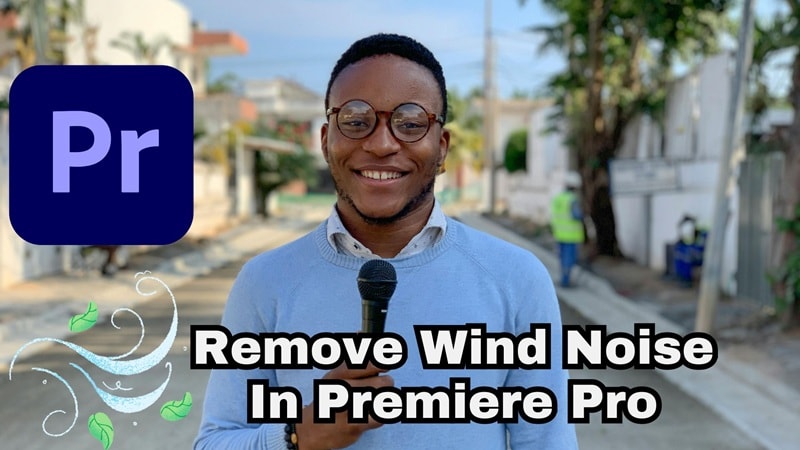
Part 1. How to Remove Wind Noise in Premiere Pro and Fix Messy Audio Fast
Thankfully, if you're trying to figure out how to get rid of wind noise in Premiere Pro, the program gives you a few different options. Some are quick and super easy for beginners, while others give more control if you like tweaking settings. Let's go through the three main ways you can clean up messy audio.
Method 1: Using Quick Tools in the Effects Panel
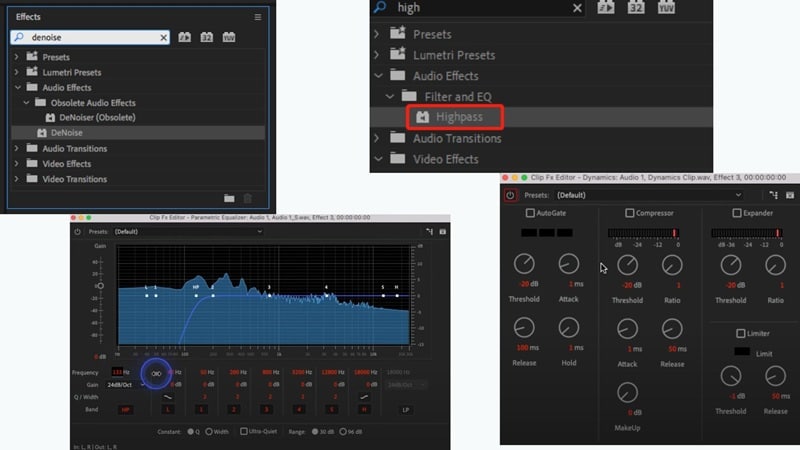
Premiere Pro already comes with built-in audio effects that help with wind noise, so you don't need anything extra. Here they are:
- High Pass Filter: cuts out low rumbling frequencies caused by wind.
- DeNoise Effect: lowers constant background noise like steady wind.
- Parametric Equalizer: lets you fine-tune sound by removing problem frequencies.
- Dynamics Effect: helps even out levels and reduce sudden noise spikes.
You can find all of these Premiere wind noise reduction effects under Effects > Audio Effects and drop them onto your clip. Then, adjust settings in the Effect Controls panel until the audio feels clean.
Method 2: Using Essential Sound Panel (Beginner-Friendly)
If you're just starting out and want an easier way learning how to reduce wind noise in Premiere Pro, the Essential Sound panel is the one method to try. To learn how to do that, check out the simple tutorial below:
Step 1: Select your clip in the timeline.
Step 2: Go to Window > Essential Sound.
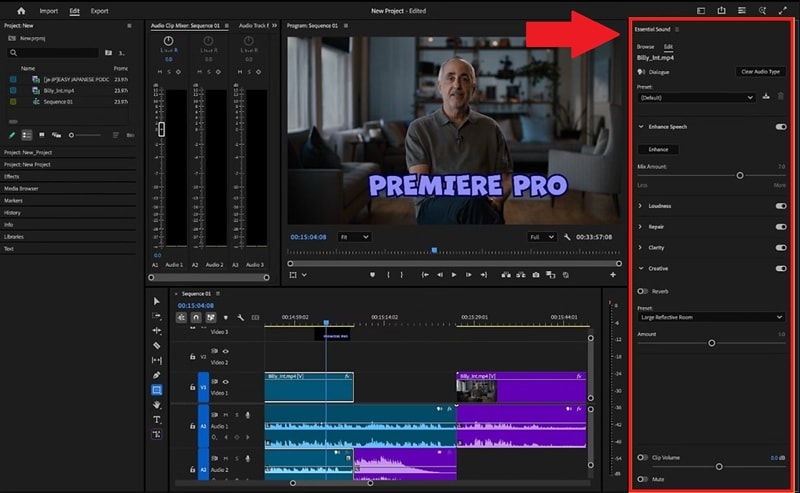
Step 3: Mark your clip as Dialogue to unlock repair tools.
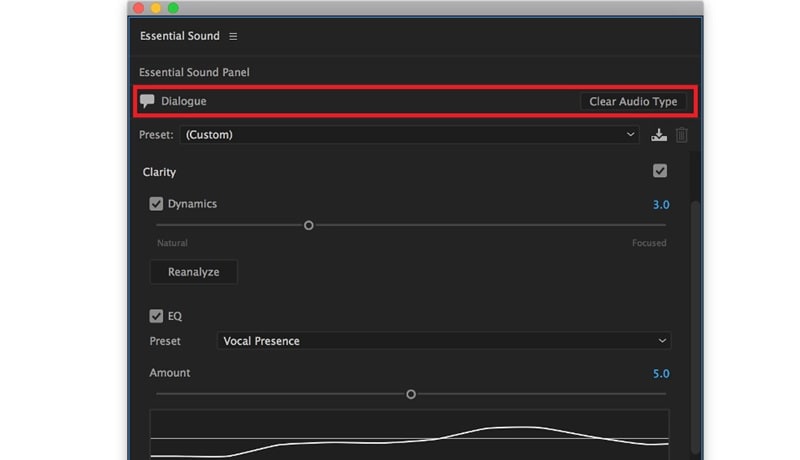
Step 4: Enable Reduce Noise and slide to the right to cut steady wind.
Step 5: Turn on Reduce Rumble to remove deep, low-end wind sounds.
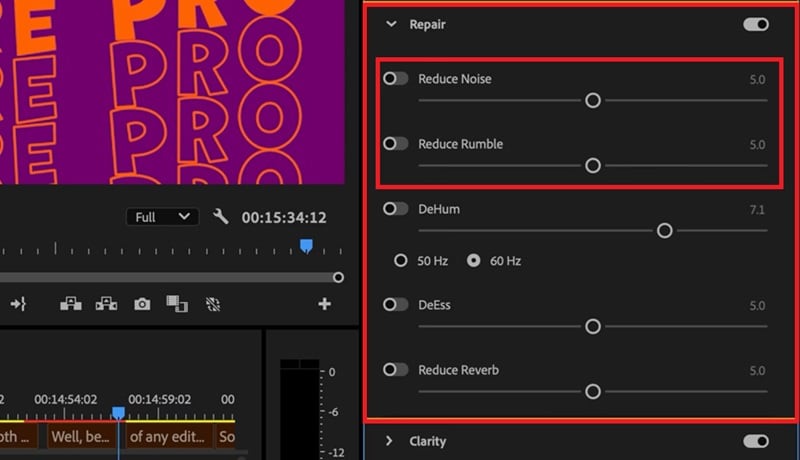
Advanced Options (Optional)
If your recording has a really bad wind and you need more precise fixes, then using the built-in Premiere Pro to remove wind noise might not be enough. In that case, here are a couple of pro-level options you can try:
- Adobe Audition: This is Adobe's dedicated audio editor. You can use features like Noise Print Capture or the Spectral Frequency Display to spot and cut out wind noise with a lot more precision.
- Third-Party Plugins: Plugins such as CrumplePop WindRemover are made specifically for cleaning up wind noise. They work automatically and save you time if you want quick, professional results without heavy tweaking.
- Pro Tip: If one method doesn't fully solve it, don't be afraid to combine them. For example, use a High Pass Filter first, then add DeNoise, and finally polish with the Essential Sound panel.
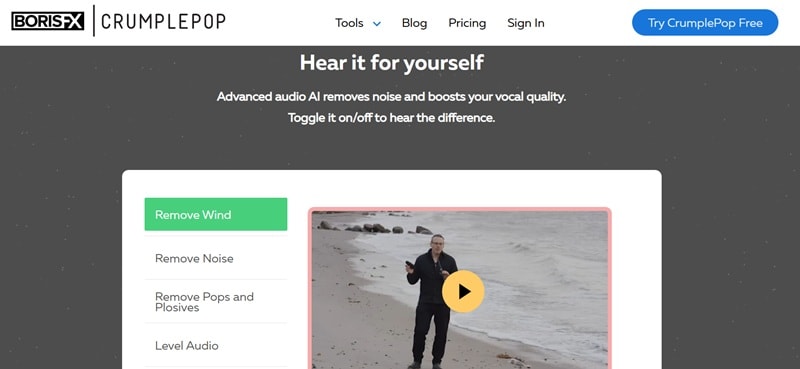
Part 2. A Smarter Shortcut: Using Filmora's AI Audio Denoise
After trying out different ways to remove wind noise in Premiere, you'll notice that while the tool can clean up wind noise, it often takes some tweaking to get it right. And if you're new to editing, the controls can feel a little overwhelming.
If you'd rather skip the trial and error and let the software handle the messy parts, Wondershare Filmora has a faster way. Its AI Audio Denoise feature is built to recognize and reduce wind noise automatically, so your audio sounds clean with almost no effort on your part.

Why Turn to Filmora for Quick Audio Denoising
Filmora's AI Audio Denoise takes a lighter approach and makes cleaning up wind noise simple, which can be a better fit if you just want clear audio without extra hassle. To give you a clearer picture, here's how it compares side-by-side with Premiere Pro wind noise reduction tool.
| Category | Filmora | Premiere Pro | Notes |
| Ease of Use | One-click setup, beginner-friendly | Steeper learning curve, more trial and error | Filmora is faster for beginners |
| How It Works | AI-powered tool designed to detect and remove wind automatically | General noise reduction effects that need manual tweaking | Filmora simplifies workflow with AI |
| Compression Loss | Voices stay natural and clear after cleanup | Risk of processed or robotic sound if over-adjusted | Premiere requires careful adjustments |
| Track Handling | Cleans multiple tracks (dialogue, music, effects) in one go | Each track needs separate tools and settings | Filmora saves time on multi-track projects |
| Clarity Boost | Enhances voice clarity while reducing background noise | Requires EQ or extra adjustments | Filmora simplifies clarity enhancement |
| Platform Support | Windows, macOS, Android, iOS | Windows, macOS | Filmora supports more platforms |
Step-by-Step: Remove Wind Noise in Filmora
To see for yourself how simple it actually is to remove wind noise using Filmora's AI Audio Denoise, check out the quick guide below:
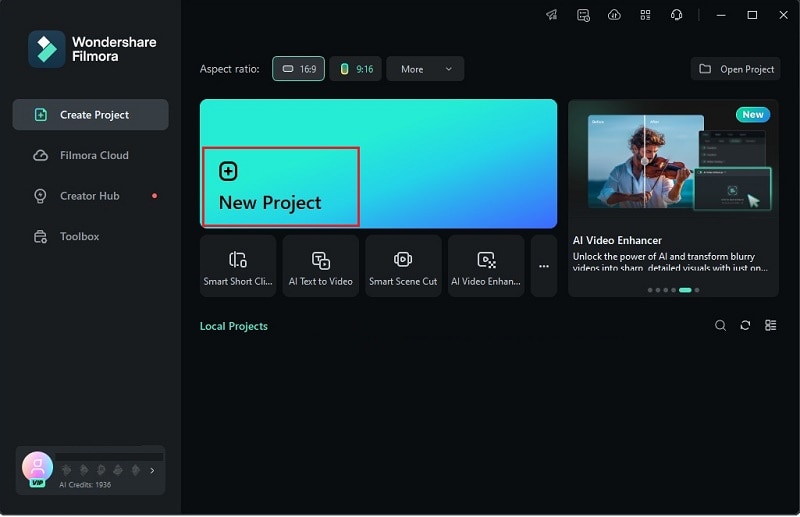
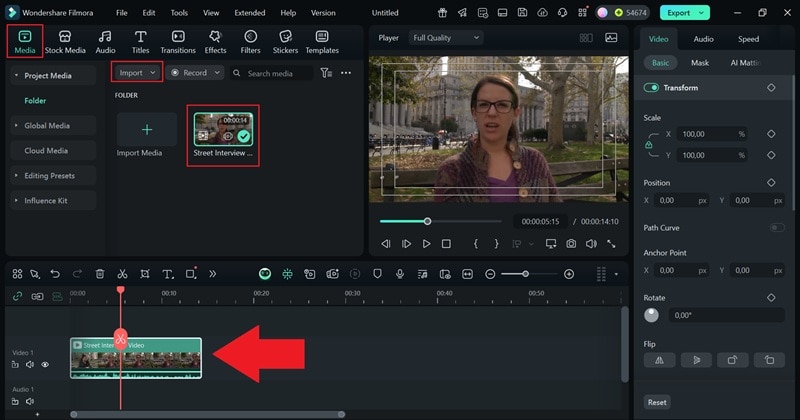
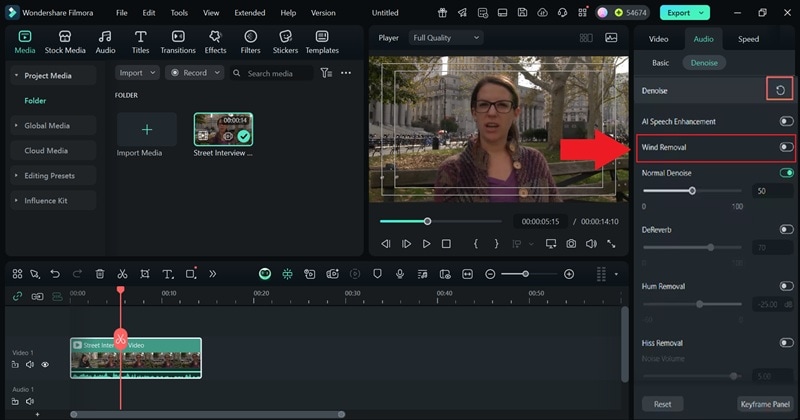
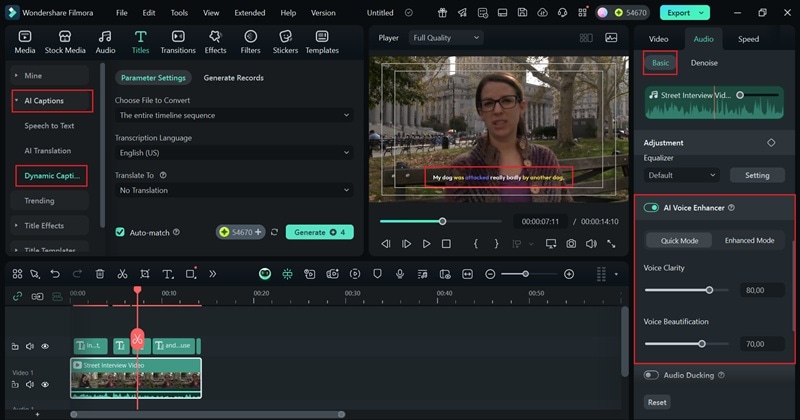
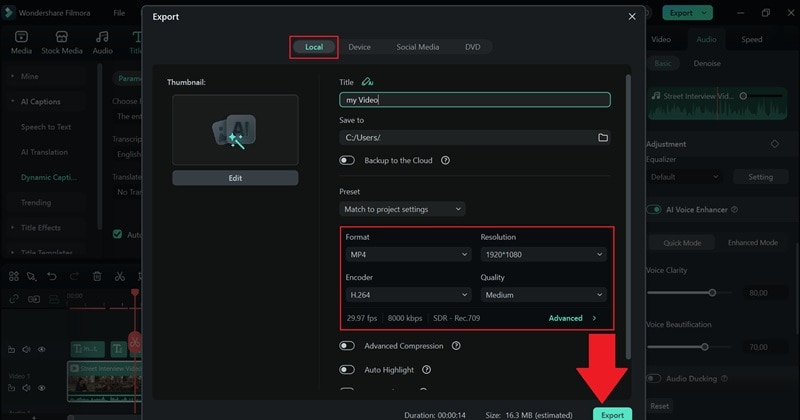
And just like that, your clip is now all improved! The audio is clear, and the visuals can be polished with the same set of tools. In the end, Premiere Pro wind noise reduction gives you powerful control, but it takes time to learn. Filmora, on the other hand, makes it quick and easy with AI-powered tools that handle wind noise in only a few clicks.
Both options can help you get cleaner, more professional audio, it just depends on how much control you want versus how fast you want results.
Part 3. More Than Just Wind Noise: What You Can Do with Noise Reduction Tools
By now, you've learned how to remove wind noise in Premiere Pro and tested Filmora's AI Audio Denoise, and you can already tell how much cleaner your audio sounds. But the difference for Filmora is that it doesn't just stop at cleaning up wind noise.
The same audio denoise feature can handle all kinds of unwanted sounds and even help polish your voice to make it clearer. Here are a few things you can do with it:

- Clear Out The Hum: Filmora's audio denoise takes care of that low buzzing sound you sometimes get from bad cables or nearby electronics. For example, if you're recording guitar at home and there's a faint hum in the background, the tool cleans it up so all you hear is the music.
- Quiet The Hiss: That sharp hiss from cheaper mics can make audio hard to listen to, but this feature softens it right away. So. if you're filming a vlog with a basic microphone, your voice still comes through crisp without that constant hiss in the background.
- Tone Down The Echo: Recording in a big room often makes everything sound hollow, but reverb reduction smooths it out. With this, you can shoot a video in an empty hall and end up with audio that feels like it was recorded in a cozy studio.
- Bring The Voice Forward: When there's too much going on around you, voice isolation keeps the focus on the speaker. Imagine sitting in a busy café recording an interview, and Filmora makes it sound like the two of you are talking in a quiet space.
Conclusion
Many people want to know how to get rid of wind noise in Premiere Pro, and it makes sense since it's one of the most popular editors around. So, we went through different ways to remove wind noise in Premiere Pro, from built-in sound effects and the Essential Sound panel to more advanced tools like Adobe Audition or third-party plugins.
Still, all those Premiere Pro wind noise reduction methods can feel overwhelming if you are just starting out. If you prefer something simple, Filmora is a great choice because its AI Audio Denoise feature has a dedicated wind noise removal that clears up your audio in a single click. On top of that, Filmora also gives you extra AI tools like voice enhancement and auto captions, making it a complete package for both audio and video editing.
FAQs about Premiere Pro Wind Noise Reduction
-
Can I completely remove wind noise in Premiere Pro?
Premiere Pro wind noise reduction can make a big difference, but it doesn’t always erase it perfectly. Light wind usually cleans up well, while heavy gusts may still leave some traces even after you apply DeNoise or the Essential Sound panel. -
What’s the difference between Reduce Noise and Reduce Rumble in Premiere Pro?
Reduce Noise focuses on steady sounds in the background, like constant wind or hums. Reduce Rumble targets the deep low-end vibrations, so it works best for that heavy wind rumble that makes audio sound muddy. -
Does Premiere Pro have an automatic wind noise remover?
Premiere Pro remove wind noise tools are helpful, but they still need a bit of adjusting. There isn’t a one-click automatic button, so you’ll need to fine-tune sliders or combine effects for the best result. -
How do I prevent wind noise when recording?
The easiest fix is stopping wind noise before it happens by using a foam cover or a furry windshield on your mic. Pointing the mic away from strong gusts and recording in a more sheltered spot also keeps your audio much cleaner.


